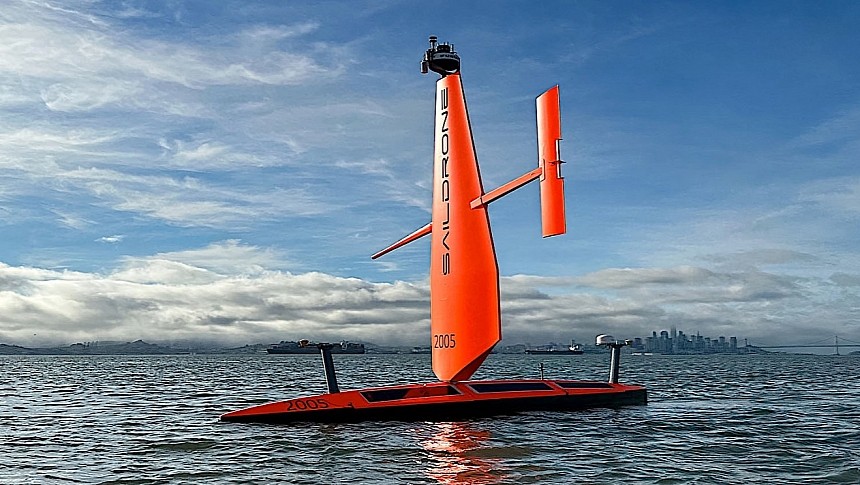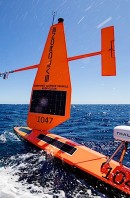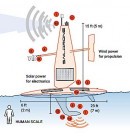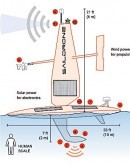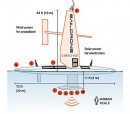There is a massive push in the world to create uncrewed autonomous maritime vessels for various uses. Somewhat eclipsed by what's going on in the aviation industry, this push results at times in incredible achievements. Like the first-ever ABS classification for such a boat.
ABS stands for American Bureau of Shipping and it's an organization tasked with "providing classification services for marine and offshore assets" in the public interest. It's an undertaking so important that many of the world's ports don't allow vessels in without an ABS seal of approval.
To date there was no seal of approval for an uncrewed surface vehicle (USV), at least not that we know of. A company called Saildrone managed to change that.
Saildrone makes seafaring drones of sorts that can be used for anything from ocean mapping to military operations. It's also the company responsible for the first-ever crossing of an ocean by a USV, something that happened back in 2013.
Saildrone makes three such vessels, namely the Explorer, Voyager, and Surveyor. Generally speaking they all use a combination of wind and solar energy, backed by conventional engines in some cases, that allows them to operate uninterrupted in the vastness of the oceans for up to a year.
It's the Voyager that's of interest to us today. The 33-foot (10-meter) is the mid-level offering, and it was specifically designed for seafloor classification, mapping, and remote area exploration.
To do all that it comes packing a high-resolution multibeam echosounder (MBES), sensors for intelligence, surveillance, and reconnaissance, a digital radar, and sub-surface acoustics.
We were told this week the drone became the "first-ever commercial USV" to receive ABS classification, meaning it will now to able to be deployed in both the ports and the national waters that require it.
It might not seem like much for us average Joes with little interest in sea drones, but it could mark a pivotal moment for oceanic research. Saildrone now plans to expand "data delivery for scientific organizations, government agencies, and commercial partners," and that can only mean we'll soon significantly advance our knowledge about the last vast unexplored territory of our planet.
As for the other two drones, the entry-level Explorer is just 23 feet (7 meters) long and it too can mostly be used to collect ocean data, including fishery-relevant indicators.
At the opposite end there is the Surveyor. This is a monstrous 72-foot (22-meter) long drone that, aside from wind, draws power from a 75 hp diesel engine. Boasting a speed of seven mph (11 kph), it's meant for prolonged stays at sea: up to 180 days. Its size and gear allows it to look down into the water to depths as great as 23,000 feet (7,000 meters).
To date there was no seal of approval for an uncrewed surface vehicle (USV), at least not that we know of. A company called Saildrone managed to change that.
Saildrone makes seafaring drones of sorts that can be used for anything from ocean mapping to military operations. It's also the company responsible for the first-ever crossing of an ocean by a USV, something that happened back in 2013.
Saildrone makes three such vessels, namely the Explorer, Voyager, and Surveyor. Generally speaking they all use a combination of wind and solar energy, backed by conventional engines in some cases, that allows them to operate uninterrupted in the vastness of the oceans for up to a year.
It's the Voyager that's of interest to us today. The 33-foot (10-meter) is the mid-level offering, and it was specifically designed for seafloor classification, mapping, and remote area exploration.
To do all that it comes packing a high-resolution multibeam echosounder (MBES), sensors for intelligence, surveillance, and reconnaissance, a digital radar, and sub-surface acoustics.
We were told this week the drone became the "first-ever commercial USV" to receive ABS classification, meaning it will now to able to be deployed in both the ports and the national waters that require it.
It might not seem like much for us average Joes with little interest in sea drones, but it could mark a pivotal moment for oceanic research. Saildrone now plans to expand "data delivery for scientific organizations, government agencies, and commercial partners," and that can only mean we'll soon significantly advance our knowledge about the last vast unexplored territory of our planet.
As for the other two drones, the entry-level Explorer is just 23 feet (7 meters) long and it too can mostly be used to collect ocean data, including fishery-relevant indicators.
At the opposite end there is the Surveyor. This is a monstrous 72-foot (22-meter) long drone that, aside from wind, draws power from a 75 hp diesel engine. Boasting a speed of seven mph (11 kph), it's meant for prolonged stays at sea: up to 180 days. Its size and gear allows it to look down into the water to depths as great as 23,000 feet (7,000 meters).
